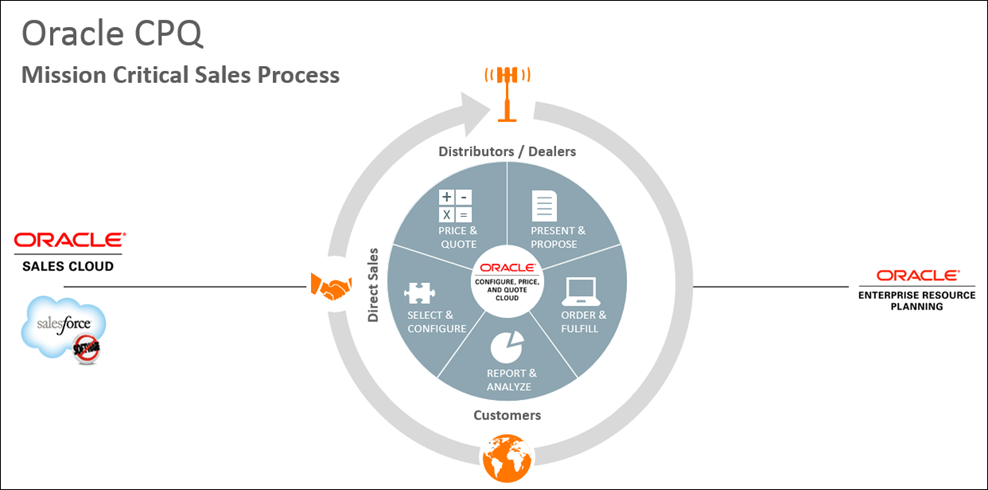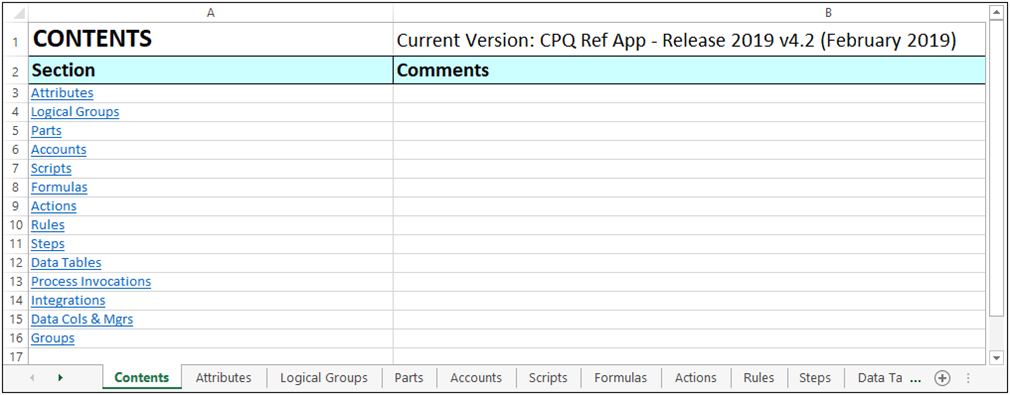Oracle CPQ Reference Application
Overview
Oracle Configure, Price, and Quote (CPQ) enables companies to streamline the entire opportunity-to-quote-to-order process, including product selection, configuration, pricing, quoting, ordering, and approval workflows. Oracle CPQ provides a flexible, scalable, enterprise-ready solution ideal for companies of all sizes that sell products and services across direct, indirect, and e-commerce sales channels.
The Oracle CPQ Base Reference Application, commonly referred to as the RefApp, is a pre-built Commerce process with standard features used by virtually all customer implementations to support their sales process. As an app-building toolkit for quoting and ordering solutions, Oracle CPQ uses the RefApp to promote product standardization, provide standard CRM and ERP integration elements, and enhance the ability of Oracle CPQ to release packages of features that deliver additional value to customers. With the various integration, configuration, and customization options available to customers, the Oracle CPQ administration and sales-user experience is different for each customer.

RefApp Images
One of three RefApp images is provisioned to each new Oracle CPQ customer based upon the CRM of choice:
- Base (this includes not CRM integrations, but is used when integrating with Microsoft Dynamics)
- Oracle Sales
- Salesforce (SFDC)
The Base RefApp contains all of elements of a basic, lowest common denominator Commerce implementation, including process actions and invocation, attributes, actions, layout, steps, participant profiles, plus it includes some custom attributes for Parts. The Oracle Sales and Salesforce RefApp images contain the Base RefApp content PLUS the content required for the CRM integrations to work out-of-the-box. The variable names for all elements are identical across all three images for the common content. CRM-specific content includes Integrations, Integration XSLs, Account custom attributes, CRM-aligned styling, and a basic Desktop Layout.
RefApp Details
File Manager is an integral part of CPQ. Customers can upload any kind of file to the File Manager, organize files into folders, and access files from anywhere on the internet. File Manager is used to store external images, JavaScript files linked to various areas on the Oracle CPQ site, CSS style sheets for Configuration flow templates, and Excel spreadsheets to hold master data.
The RefApp content is detailed in an Excel catalog located in the About folder in File Manager, which also contains README and RefApp version information files.

The README file identifies the RefApp version and date.

The RefApp Version Info (RefAppVersionInfo.txt) file summarizes the enhancements and bug fixes included in the current RefApp image on the customer’s site.

The Excel catalog (CatalogOfRefAppElements.xlsx) is an important resource for administrators, providing a central compiled inventory of the contents of all of the RefApp images. Elements that are shown as part of the Base RefApp are included in all three RefApp images. Before implementing customizations, Oracle recommends administrators first review the Excel catalog to see the components already available to them.

The following table describes the Excel catalog tabs.
|
Element Type |
Description |
|---|---|
|
Attributes |
Attributes are stand-alone input fields that contain Transaction data. Attributes and attribute sets can apply to a Transaction as a whole, or its specific line items. The RefApp includes attributes and attribute sets for collecting data such as billing, shipping, and pricing information. |
|
Logical Groups |
Oracle CPQ attributes and elements are organized into logical groups to support core Oracle CPQ functionality such as Approvals, Assets, and ERP and CRM integrations. This tab is used to group similar attributes on the Attributes tab to assist administrators when creating new attributes. This element is not present in the actual RefApp images. |
|
Parts |
Parts, often referred to as items, are administered using part attributes. Standard part attributes such as Product Group and Price Type are included in the RefApp. |
|
Accounts |
Accounts are a tool for supporting collaborative customer management. Once customer records exist in accounts, they are accessible to sales agents, channel agents, and full access users. The RefApp provides account attributes and integrations in support of customer management. |
|
Scripts |
BML (BigMachines Extensible Language) is a scripting tool used to capture a company's complex business logic within Oracle CPQ Configuration and Commerce. The RefApp images contain scripts, such as for rolling up transaction status and for calculating a price expiration date. |
|
Formulas |
Formulas set Transaction-level and line-level attribute values through a drag and drop interface and a visual editor, enabling administrators to build complex calculations without scripting. The RefApp images contain standard calculations for pricing, revenues, and totals. |
|
Actions |
Commerce actions trigger events within a Commerce process, Transaction, or Transaction line to occur. The RefApp images contains actions for saving the transaction, configuring products, and integrating with CRM applications. |
|
Rules |
Rules enable administrators to set specific configuration information for products and hide some configuration attributes from certain user types. The RefApp images contain hiding and validation rules for the commerce transaction. |
|
Steps |
Workflows are made up of steps, which define the states transactions can be in, as well as document permissions and routing. The RefApp images contain a standard workflow for sales and administrative users. |
|
Data Tables |
Data tables are used to store product and Commerce data and are accessible from any part of the Oracle CPQ application where BML is used. The RefApp contains data tables for rolling-up Transaction-line level statuses to a single Transaction-level status. |
|
Process Invocations |
Process Invocation creates buttons that link product catalog pages with Commerce processes. Buttons are available on various Oracle CPQ pages to invoke process actions. |
|
Integrations |
The Oracle CPQ RefApp images contain pre-defined integrations to Salesforce or Oracle Sales. |
|
Data Cols & Mgrs |
Data Columns are used to define the subset of commerce attributes available for Reporting and Search. The RefApp images provide a standard set of predefined data columns. |
|
Groups |
Groups are a collection of users and are useful for determining access rights to Commerce Transactions and Transaction lines. The RefApp images provide a standard set of sales and administrator groups. |
Administration
![]() Access Information for Your CPQ Site Reference Application
Access Information for Your CPQ Site Reference Application





